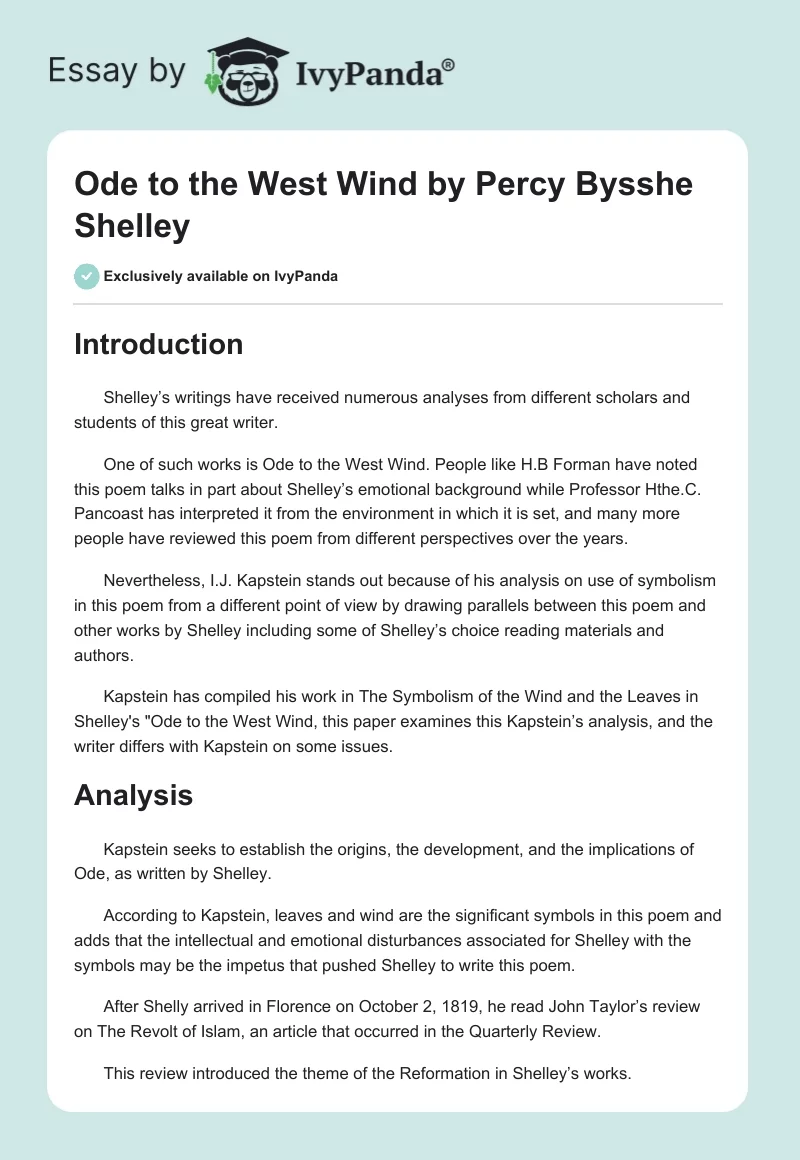Introduction
Shelley’s writings have received numerous analyses from different scholars and students of this great writer.
One of such works is Ode to the West Wind. People like H.B Forman have noted this poem talks in part about Shelley’s emotional background while Professor Hthe.C. Pancoast has interpreted it from the environment in which it is set, and many more people have reviewed this poem from different perspectives over the years.
Nevertheless, I.J. Kapstein stands out because of his analysis on use of symbolism in this poem from a different point of view by drawing parallels between this poem and other works by Shelley including some of Shelley’s choice reading materials and authors.
Kapstein has compiled his work in The Symbolism of the Wind and the Leaves in Shelley’s “Ode to the West Wind, this paper examines this Kapstein’s analysis, and the writer differs with Kapstein on some issues.
Analysis
Kapstein seeks to establish the origins, the development, and the implications of Ode, as written by Shelley.
According to Kapstein, leaves and wind are the significant symbols in this poem and adds that the intellectual and emotional disturbances associated for Shelley with the symbols may be the impetus that pushed Shelley to write this poem.
After Shelly arrived in Florence on October 2, 1819, he read John Taylor’s review on The Revolt of Islam, an article that occurred in the Quarterly Review.
This review introduced the theme of the Reformation in Shelley’s works.
Kapstein notes that Shelley loved walking as part of his many recreational activities and one day on his way from these walks, he wrote to his friends explaining to them how he loved watching the leaves and the flow of water in the Arno.
Kapstein argues that Shelley’s mention of leaves to his friends connects to his eventual use of the same in the Ode.
Nevertheless, the writer differs with this opinion because there is no strong and conclusive relation of watching leaves along the banks of River Arno and then use of the same as a symbol of transformation.
Even though Shelley later revealed that he wrote this poem in a wood that skirts the Arno, the mention of leaves in the letter does not correlate in any way with the symbolic leaves in the poem.
Kapstein goes ahead to say the fact that Shelley said he wrote this poem in the woods, which logically have left, does not mean this poem has anything to do with leaves in the woods of River Arno.
As aforementioned, Kapstein notes that Shelley’s mention of the origin of this poem is shallow and there is more to it because the poem itself does not talk of a storm that blows leaves away literally.
Kapstein sees more in this poem than strong winds blowing leaves across this Italian landscape, no; blowing wind and flying leaves symbolized Shelley’s beliefs on the constantly changing nature and humankind.
Kapstein holds that winds and leaves were symbols of the changing nature and humankind in this poem.
To understand this symbolism well, Kapstein gives their meaning by explaining their use in stanza one where leaves are flying before the wind, a destroyer of the leaves, but a preserver of seeds for the next generation.
In the fourth stanza, Shelley prays that he, just like the leaf and cloud, may experience the power of the wind to attain his regeneration while in the fifth stanza he wishes that the wind would bring the cycle of regenerating seasons upon humankind.
From this context, Kapstein notes that the wind symbolizes the destroyer of the older generation represented by flying leaves and preserver of the new generation represented by seeds.
Shelley himself symbolized change, and in the presence of the wind, he would soon die (destroyed), but his seeds (children), would arise thus causing a continuous cycle of regeneration. Therefore, leaves here symbolize things that are subject to change like humankind.
Kapstein traces Shelley’s works to determine his stand on the inevitability of change in life. For instance, he notes that in Song, one of Shelley’s earlier poems talks of cycles of seasons, which is analogous to those in the Ode.
Moreover, Shelley was a student of Lucretius who believed in the power of change in nature; therefore, Shelley might have been driven by these influences as he wrote the Ode.
Kapstein consults deeply the application of the same notion in Shelley’s other poem Queen Mab. In this poem, Shelley talks of seasons of change in nature which ties closely to that in the Ode. Finally, Kapstein notes that on November 12, 1819, Shelley got a son and this may signify his rebirth.
However, the writer differs with these claims because the above-mentioned analysis of symbolism in this poem goes back to several years before this son was born and to claim that this son added to the poem is immaterial.
Conclusion
Kapstein gives a compelling interpretation of the use of symbolism in the Ode to the West Wind. It is clear that Shelley believed in the inevitability of change, which occurred in cycles, and in this poem, he sees the wind as the destroyer of the older generation giving way to the new generation.
Leaves here symbolize things that are subject to change like humanity. Nevertheless, the writer disagrees on two occasions where Kapstein draws insignificant correlations between Shelley’s life and his poem. In summation, Kapstein did a great analysis of the use of symbolism in this poem.


